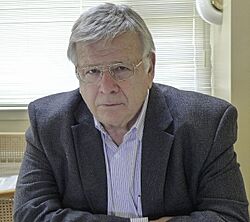Gerald Guralnik facts for kids
Quick facts for kids
Gerald Guralnik
|
|
|---|---|

Gerald Stanford Guralnik
|
|
| Born | September 17, 1936 |
| Died | April 26, 2014 (aged 77) |
| Nationality | American |
| Alma mater |
|
| Known for |
|
| Awards |
|
| Scientific career | |
| Fields | Physics Computational physics Quantum field theory |
| Institutions |
|
| Doctoral advisor | Walter Gilbert |
Gerald Stanford "Gerry" Guralnik (born September 17, 1936 – died April 26, 2014) was an important American physicist. He was a professor at Brown University. Dr. Guralnik is best known for his work on the Higgs mechanism and the Higgs boson. He helped discover these ideas in 1964 with his colleagues C. R. Hagen and Tom Kibble.
Their discovery was a big step in understanding how tiny particles get their mass. It was even called one of the most important papers in the history of Physical Review Letters, a famous science journal.
Contents
Understanding the Higgs Boson
The Higgs boson is a very special particle. Scientists believe it helps give other particles their mass. Imagine a room full of people. If a popular person walks through, people gather around them, making it harder for them to move quickly. This "stickiness" is like how particles get mass from the Higgs field.
The Higgs Mechanism Explained
The Higgs mechanism is the scientific idea that explains how the Higgs boson works. It describes how a special field, called the Higgs field, fills the entire universe. When other particles interact with this field, they gain mass. Particles that interact strongly with the Higgs field become heavier, while those that interact weakly remain light.
Spontaneous Symmetry Breaking
Dr. Guralnik's work also involved something called spontaneous symmetry breaking. This sounds complicated, but it's like a pencil standing on its tip. It's perfectly balanced (symmetrical), but it can't stay that way. It will eventually fall in one direction, breaking its perfect balance. In physics, this idea helps explain how the universe changed from a perfectly symmetrical state to the way it is now, allowing particles to have mass.
Awards and Education
In 2010, Dr. Guralnik received a major award called the J. J. Sakurai Prize for Theoretical Particle Physics. He earned this prize for his clear explanations of how particles get mass through the Higgs mechanism and spontaneous symmetry breaking.
Gerald Guralnik studied at some of the best universities. He earned his first degree from the MIT in 1958. Later, he received his PhD from Harvard University in 1964.
His Career Journey
After finishing his studies, Dr. Guralnik worked at several important places. He was a research fellow at Imperial College London and the University of Rochester. In 1967, he joined Brown University, where he became a Chancellor's Professor. He also spent time working at the Los Alamos National Laboratory, a famous research center.
Gerald Guralnik passed away in 2014 at the age of 77. His work remains a key part of our understanding of the universe's fundamental building blocks.
See also
- Higgs mechanism
- Higgs boson

